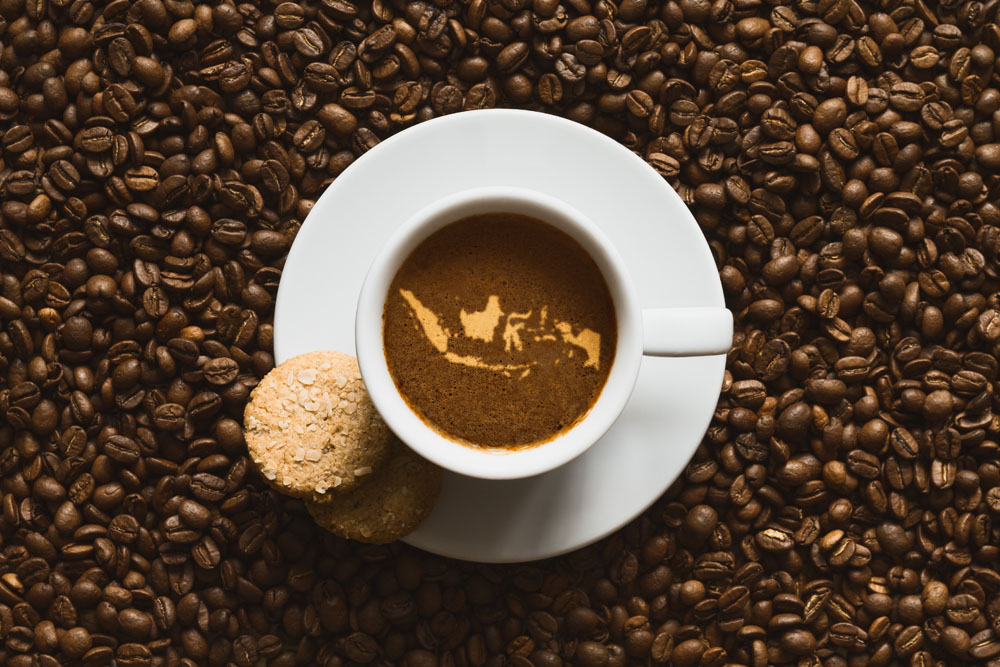Possibly one of the most divisive beans around, Sumatran coffee is a true “love it or hate it” beverage. Thanks to the growing popularity of light roasted, Latin American coffees that emphasise clean and bright tastes, the heavy, grainy taste of Indonesian beans is falling out of favor. However, for those willing to try something a little unusual, the herbal earthiness of Sumatran coffee is worth trying.
Region and history
Indonesia is one of the major coffee growing regions and the fourth largest coffee producer in the world. In fact the term java—a colloquial name for coffee—is derived from the Java region in Indonesia. The islands are ideally located on the equator, and the various mountain regions offer the perfect climate and elevation to successfully grow Arabica coffee beans. Coffee production was first introduced in the region by Dutch colonials in 1696. Since then the production of coffee has become a crucial part of the Indonesian economy.
Sumatran coffee, unsurprisingly, is grown on the Sumatran island in the Western region of Indonesia.
Wet-hulling processing

The unusual taste of Sumatran coffee is largely a result of the manner in which the beans are harvested and processed. Most coffee is processed in one of two ways: Wet or Dry. The Wet process involves removing the fruit covering the coffee bean before it is washed and dried. The Dry process on the other hand involves leaving the fruit out in the sun until the fruit is dried and easy to remove.
Sumatran coffee on the other hand is processed using a method called Giling Basah, or Wet-hulling. This process involves removing the skin of the fruit and leaving the fruit to sit for about a day. Then the fruit is washed off and the bean is left to dry. This process results in beans that have a higher than normal moisture content.
Flavor profile

Unlike other coffees we have looked at in this series, Sumatran coffee production is not limited to a tiny geographic area. In fact Sumatra is one of the largest islands in Indonesian and produces a huge amount of coffee. Thanks to the large geographic growing region and the sheer number of farms, there is bound to be a fair degree of variation in the taste of Sumatran coffee beans. However there are certain qualities that are present in pretty much all beans from this region.
The Giling Basah process results in a coffee that has very little acidity and a full body. This means that Sumatran coffee is very rich, creamy, and smooth. In terms of flavors, Sumatran beans are known for their earthy, herbal, and spicy taste. It’s not uncommon to also tastes notes of mushrooms, fungus, moss, leather, and wood.
Food pairings

Thanks to its spicy, herbal flavor and smooth texture, Sumatran coffee pairs extremely well with sweet and creamy deserts. Try drinking a cup with some cheesecake, creme brûlée, banana bread, or anything involving cinnamon or maple syrup.
If you’re feeling like something more intense, mushrooms can really bring out the flavor of the coffee. A mushroom and cheese quiche is a great pairing with Sumatra.




I recently “rediscovered” Sumatran coffee after 25 years or so of various coffees, mainly of the k-cup variety. I think what brought me back to Sumatran was taste-memory. I remember enjoying the coffee black. I was finding myself having to put milk, almond milk or some other derivative to enjoy a brew. Coffee from Indonesia, and Sumatra in particular, tastes good to me without dairy, non-dairy or sweetners.